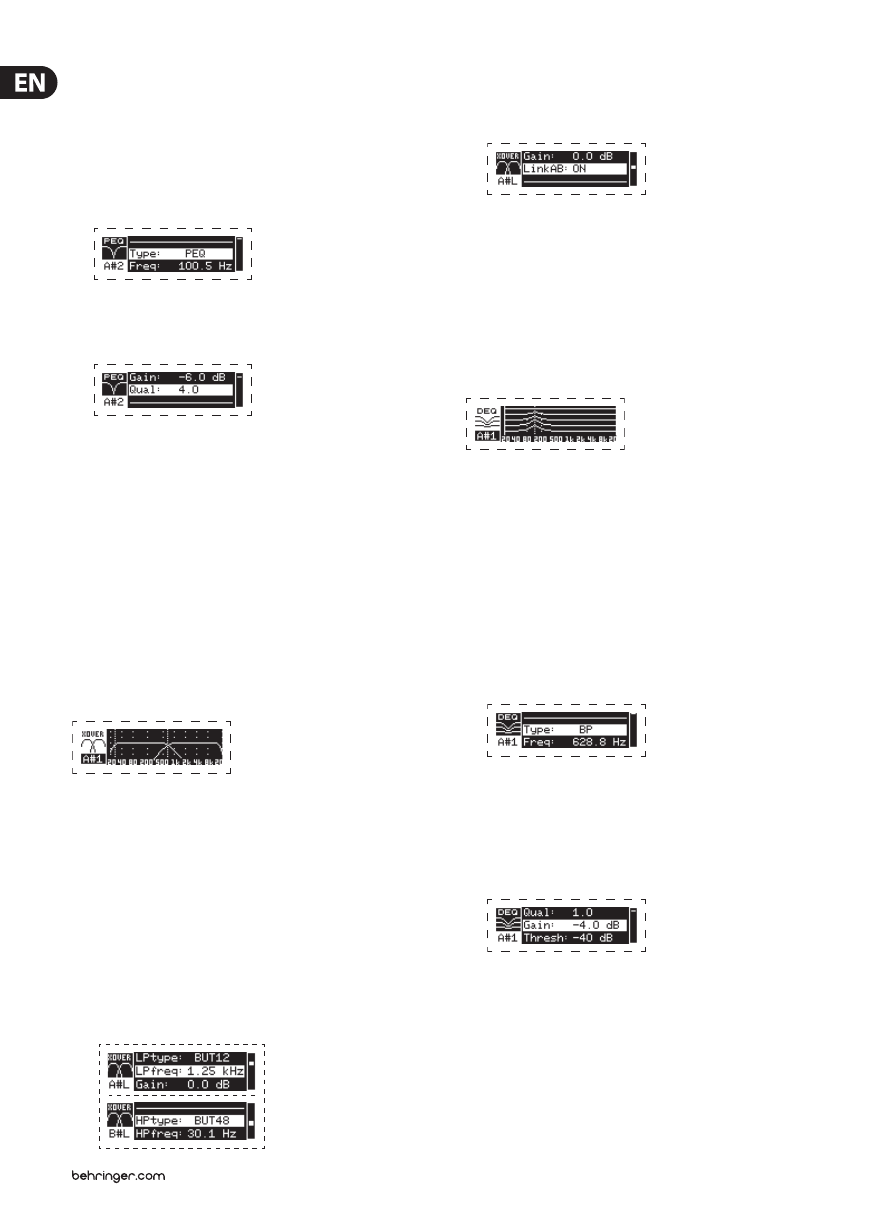
8
iNUKE NU6000DSP/NU3000DSP/NU1000DSP User Manual
2. Press the SELECT encoder knob to enter the parameter screens for your
chosen EQ band.
3. Press the UP / DOWN arrow keys to switch between parameters. The chosen
parameter will appear highlighted.
4. Rotate the SELECT encoder knob to change parameter values.
5. Choose the equalizer type (Type): OFF, PEQ (parametric), low shelving
(LS6, LS12), or high shelving (HS6, HS12).
6. Set the frequency (Freq) for each EQ band by rotating the SELECT encoder knob.
The programmed frequency can represent either the center frequency for
parametric mode, or the cutoff frequency for low and high shelving modes.
7. Set the EQ band’s cut or boost (Gain) by rotating the SELECT encoder knob.
8. For parametric mode, control the width of the parametric curve by tweaking
the Qual parameter. High Qual values produce a narrow, steep curve, while
low Qual values create a wide curve with a gentle slope.
9. Press the SELECT encoder knob or the EXIT button to return to the top-level
PEQ screen.
XOVER
The XOVER module offers programmable pairs of high- and low-pass filters.
STEREO and BRIDGE modes possess only one filter set (A#1). DUAL, BIAMP1,
and BIAMP2 modes use two filter sets (A#1 and B#1), and in BIAMP1 and BIAMP2
modes, these two sets of filters may be linked.
On the top-level screen, vertical dotted lines indicate the threshold point for
each filter.
Each low-pass and high-pass filter also offers multiple options for filter
type and slope: OFF, Butterworth (BUT6, BUT12, BUT18, BUT24, BUT48),
Bessel (BES12, BES24), or Linkwitz-Riley (LR12, LR24, LR48).
Programming filters/bi-amping crossover
1. Choose between filter sets A#1 and B#1 by rotating the SELECT encoder knob
(DUAL, BIAMP1, and BIAMP2 modes only).
2. Press the SELECT encoder knob to enter the parameter screens.
3. Move up or down between parameters by pressing the UP / DOWN
arrow buttons.
4. Choose between filter types for high-pass (HPtype) and low-pass (LPtype)
by rotating the SELECT encoder knob.
5. Set the filter thresholds for high-pass (HPfreq) and low-pass (LPfreq) by
rotating the SELECT encoder knob.
6. Set the filter’s overall signal gain (Gain) by rotating the SELECT encoder knob.
7. Set the link parameter (LinkAB) to ON or OFF by rotating the SELECT encoder
knob (BIAMP1 and BIAMP2 modes only).
8. Press the SELECT encoder when finished to return to the top-level XOVER screen.
DEQ
The DEQ module deploys a dynamic EQ that is triggered by a programmable
signal thresold. For example, you can program the dynamic EQ to cut or boost
increasing amounts of mid frequencies as the signal gets louder beyond your
preferred threshold.
STEREO and BRIDGE modes feature one set of dynamic EQs (A#1 and A#2),
while DUAL, BIAMP1, and BIAMP2 modes feature two sets of dynamic EQs
(A#1, A#2, B#1, and B#2). Each dynamic EQ may be set to OFF, band-pass (BP),
low-pass (LP6, LP12), and high-pass (HP6, HP12).
Programming dynamic EQs
1. Choose between dynamic EQ sets by rotating the SELECT encoder knob.
2. Press the SELECT encoder knob to enter the parameter screens.
3. Move up or down between parameters by pressing the UP / DOWN
arrow buttons.
4. Choose between EQ types (Type) by rotating the SELECT encoder knob.
5. Set the frequency (Freq) for each EQ by rotating the SELECT encoder knob.
The programmed frequency can represent either the center frequency for
band-pass mode, or the threshold frequency for low- and high-pass modes.
6. For band-pass mode, control the width of the band-pass curve by tweaking
the Qual parameter. High Qual values produce a narrow, steep curve,
while low Qual values create a wide curve with a gentle slope.
7. Set the dynamic equalizer’s cut or boost (Gain) by rotating the SELECT
encoder knob.
8. Set the signal threshold (Thresh) by rotating the SELECT encoder knob.
9. Program your desired ratio (Ratio). Similar to a compressor, higher ratio
values yield a more intense equalization effect.




































